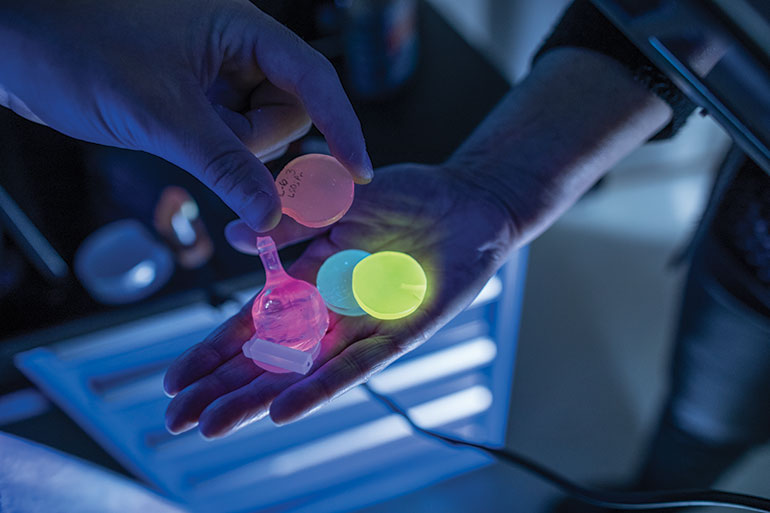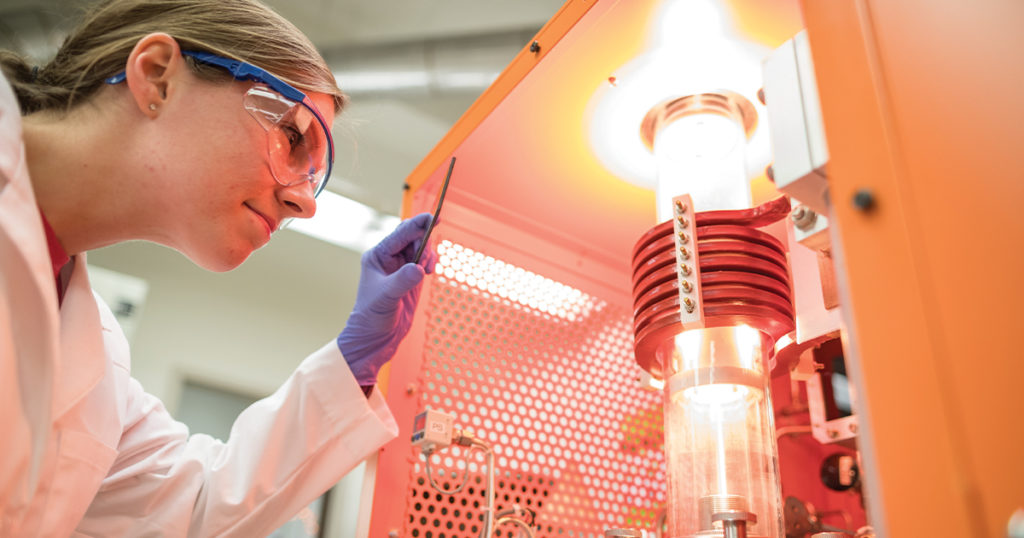Siemens, SMRC Continue Crystal-Clear Vision for Growth
By David Goddard.
Radiation is something you can’t see, touch, or smell, but need to be able to detect. Scintillators are materials that give off photons of visible light when exposed to ionizing radiation, making it possible to detect, and making scintillators very useful across a wide variety of fields.
At UT, the Scintillation Materials Research Center (SMRC) has been on the cutting edge of research and development of such materials for many years and has become internationally known for its discoveries of novel scintillators in the form of single crystals, thin films, and polycrystalline ceramics.
Scintillators are critical to PET and CT scanner technology, according to SMRC Director Chuck Melcher, who also holds a research faculty appointment in MSE.
“PET and CT scanners only perform as well as the scintillators within them,” Melcher explained. “So, continuing to improve upon them is a key development for patients around the world.”
In addition to the technological benefits to Siemens and the medical imaging community, the partnership has focused heavily on student success. Numerous engineering students have graduated with valuable skills gained from their experience working at SMRC.
Melcher pointed out Harold Rothfuss (PhD/MSE, ’13) as an example. Rothfuss, now a key scientist at Siemens, took part in several research breakthroughs related to cooping, or fine-tuning, in a sense, of crystals while working with the SMRC.
Former graduate research assistant Camera Foster (PhD/MSE, ’19), also worked with Siemens as part of her research into scintillation and luminescence while at UT.
“Working closely with Siemens taught me a great deal about the scintillator field,” she said. “It was unique because it highlighted the benefits of research on a university level as well as how that research directly impacts the industry.”
Scintillators also play a key role in national security efforts in the US.
MSE Assistant Professor Mariya Zhuravleva has honed her skills in designing and growing new types of crystals, some of which the Department of Homeland Security (DHS) can use to detect illicit cargo of a radiological nature.
Current technology uses crystals that tend to either be cost prohibitive, or not as effective as they need to be.
Zhuravleva is the overall lead on one project and is UT’s lead on a second one that are both aimed at developing new scintillators that have improved efficiency while at the same time coming with a more affordable price tag that would allow for increased use at ports of entry into the US.
Melcher and Professor Kurt Sickafus—also of MSE—round out UT’s team on the first project, while Melcher also joins Zhuravleva on the second. The Countering Weapons of Mass Destruction Office (CWMD) within DHS has a particular interest in both ideas, which were two of only seven projects from around the US chosen for funding.
“This work has the potential to be a win-win, as it strengthens our national security while at the same time helping develop the workforce of tomorrow in this key area through the research and training that our students will help conduct,” said Zhuravleva. “That hands-on experience in detection, design, and development will prove a vital part of the CWMD’s continued vigilance in the years to come.”
If past success is any indication, the future potential of the Siemens-UT partnership seems crystal clear.
Now, in its 15th “crystal anniversary” year, the center shows no signs of slowing down. SMRC and its researchers have recently won several awards and gained recognition from the scientific community. MSE alone has been responsible for several of those accolades:
- Zhuravleva was the recipient of a 2019 NSF Early CAREER Award;
- Undergraduate student Ian Greeley was named a 2019 Goldwater Scholar, among the most prestigious undergraduate STEM scholarships in the US;
- Assistant Research Professor Yuntao “Jeffery” Wu received a prestigious IEEE 2017 Radiation Instrumentation Early Career Award;
- Zhuravleva and Research Associate Merry Koschan (SMRC) were elected as president and secretary, respectively, to the American Association for Crystal Growth;
- SMRC faculty and staff have been invited to speak at conferences across the globe, including in Japan, Germany, and India.

SMRC’s origins date back to CTI Molecular Imaging, a company founded by UT engineering graduates that was a leading provider of PET and CT scanners for medical use. Siemens Medical Imaging bought CTI in 2005 and, in a joint partnership with UT, created SMRC. Since its creation, Siemens has provided SMRC more than $7 million in funding as well as in-kind gifts of technology and software. More than 20 graduate students and over 40 undergraduates have benefitted from research experiences and positions with SMRC made possible in part by Siemens’ investment.
